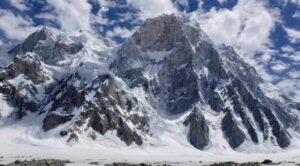Few explorers radiate the unassuming, endearing, and gentle image of Naomi Uemura. His beaming smile is recognizable globally. First, as an outstanding achiever who made the first solo ascent of Denali, the first solo rafting journey down the Amazon, and the first solo to the North Pole. Later, when he disappeared on winter Denali, he reminded us that even the best are not invulnerable.
When Uemura was born in 1940s Japan, the notion of world travel did not exist. A pegged exchange rate meant that modest workers like Uemura couldn’t afford such privilege. Although Uemura enjoyed tending his family farm in northern Hyogo Prefecture, he was curious about what other adventures lay beyond.
Uemura’s farming life sometimes involved working in harsh weather. Heavy winter snows and icy coastal winds were part of the job. He relished these aspects of life, and his bred toughness proved helpful on future expeditions.
Uemura studied agriculture at university but more significantly, he first began climbing here. Naturally shy, he joined the alpine club, hoping it would help him make new friends and gain confidence.
A humbling first climb
His first climb, up Mount Shirouma, was disappointing. He learned that long days of farmwork were no match for the physically demanding elements of climbing. But this humbling event did awaken Uemura’s undercover competitiveness. Instead of feeling beaten, he vowed to be better.
He spent the rest of his university years honing his climbing skills and working on his fitness. When Japan’s floating exchange rate began in 1973, he was ready to search abroad for the elusive adventures he craved.
With $110 in his pocket, Uemura boarded a ship to Los Angeles. Over the next four-and-a-half years, he traveled the globe, notching visionary firsts.
He joined Pemba Tenzing in the first Ngojumba Kang (Tenzing Peak) ascent. Next, he rafted 6,000km alone down the Amazon. He climbed Mont Blanc (then considered Europe’s tallest peak), Kilimanjaro, and Aconcagua. Already, he had an eye toward the world’s Seven Summits. In between, he crossed the Arctic.
Briefly, Uemura returned to Japan. Then in 1970, he joined Japan’s Everest expedition. He became the first Japanese man to stand atop the world’s highest peak.
Barely three months later, he completed the world’s first solo climb of Denali. He also became the first to climb five of the Seven Summits. He longed to climb Vinson, but never got the chance.
Four epic dogsled journeys
Not even 30 years old, Uemura already understood that he preferred solo expeditions. Long captivated by polar regions, he went to Greenland in 1973 and completed a 3,000km dogsled journey along the North West coast.
Continuously pushing his physical limits, he set off in 1976 on his most grueling journey yet — 12,000km by dogsled from Greenland to Alaska.

Naomi Uemura during his 18-month expedition from Greenland to Alaska. Photo: Ira Block/National Geographic
His mega-traverse took 18 months, with a break during the un-dogsled-able summer. No one had dogsledded from Greenland to Alaska since Knud Rasmussen’s epic Fifth Thule Expedition decades earlier. Uemura dealt with polar bears, bad ice, and brawling dogs. Against all odds, he reached Alaska. The expedition — funded by National Geographic Magazine, a Japanese newspaper, a television station, and a dog food company – cemented his reputation as a world-class explorer.
North Pole solo
In 1978, he returned to the polar regions for a shorter but even more difficult dogsled journey. He became the first to solo the North Pole, dogsledding the 760km of broken ice in 57 days. Then almost as impressive — and something which showed his bottomless appetite for adventure — he took a short charter flight from the North Pole to northern Greenland. Then he started dogsledding the length of the Greenland ice sheet.
Uemura never rested on his laurels. After each personal glory, he immediately set out to top it. His next adventure in 1984 was sadly the one that ended his life.
No one had ever soloed Denali in winter. To this day, only 13 people have summited the highest peak in North America at the harshest time of year.
Uemura carefully prepared. He slung bamboo poles over his shoulders to arrest potentially deadly crevasse falls. He slept in snow caves, eliminating the need for a weighty tent. To minimize fuel, he ate cold meat. The day after his 43rd birthday, Uemura reached the summit.
He radioed his success to a local bush pilot and photographer. He returned to 5,500m and expected to be at base camp in two days.
High winds at the summit raised concerns for his welfare. But Uemura’s reputation and experience had seemingly rendered him immortal. If anyone could make it down, he could.
News spread quickly of his ascent, and a flurry of reporters excitedly awaited his arrival. When he failed to show, excitement turned to concern. Short relief came after a plane spotted him at 5,100m. But those were the last sightings of Uemura.
Vanishes on winter Denali
It is unknown exactly what became of him. He had abandoned his bamboo poles higher up and perhaps fell into a crevasse. Thirteen days after he’d reached the summit, two experienced climbers searched the slopes for him, beginning around 4,000m. They found a snow cave, in which he’d left gear, including his bamboo safety poles, to lighten his load. He also left his diary there.
Uemura’s last entry read simply, “I wish I could sleep in a warm sleeping bag. No matter what happens, I am going to climb McKinley.” More gear was located around 5,200m, but his body has never turned up.

Unassuming, gentle and quietly driven, Naomi Uemura died at age 43.
Almost 40 years later, Uemura’s legacy continues. Adventurers active on the world stage may receive the Naomi Uemura Adventure Award. In Japan, two museums foster his memory.
But most of all, Uemura is remembered as the high achiever who pushed physical limits while remaining enviably gentle and unassuming.






